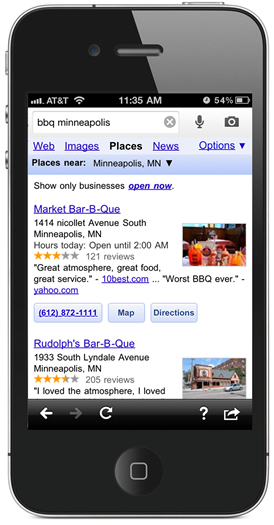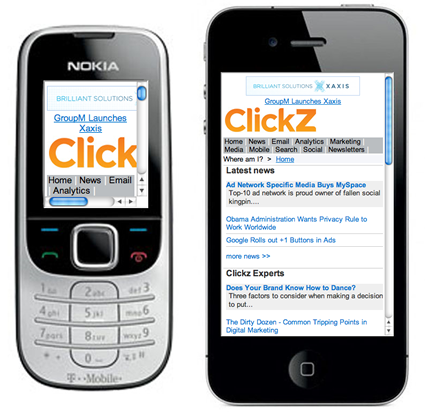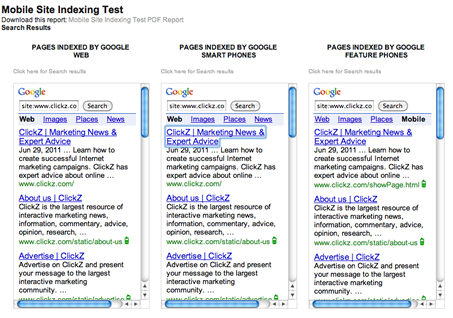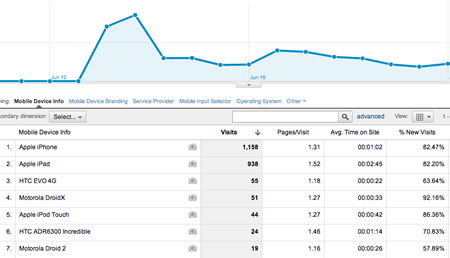 Need to learn more about smartphone and mobile SEO best practices? Let’s start with a few statistics:
Need to learn more about smartphone and mobile SEO best practices? Let’s start with a few statistics:
According to an infographic from Microsoft Tag, 51% of smartphone users are more likely to buy from a retailer with a mobile specific web site, however: only 4.8% of retailers have a mobile web site.
A recent study by Google, “The Mobile Movement: Understanding Smartphone Users” reports 77% of smartphone users visit search engine websites followed by social networks. And nine out of ten smartphone searches results in an action (purchasing, visiting a business, etc.). Mobile use is growing faster than all of Google’s internal predictions, with YouTube seeing 200 million mobile playbacks a day, according to Eric Schmidt.
To capture the market, marketers and advertisers are increasingly allocating budget to mobile. In fact, eMarketer estimates total mobile advertising spending in the US will reach $1.1 billion this year, which is up 48% over 2010. Mobile search is forecasted to account for up to 10 percent of search budgets with Google capturing 97% of that market.
How can marketers take advantage of the opportunity with mobile search & optimization?
Of course there’s paid search advertising on mobile as there is on the web, but our focus here is on content, social and organic search, so the following tips will emphasize what you can do without advertising.
Fundamental SEO Best Practices – Effective site optimization applies for mobile sites as they would for desktop websites. Search engine accessibility, keywords, content and links all matter with mobile. Keep in mind screen real estate is smaller for keyword use in titles and descriptions. As a primer, check out this post from the Google Webmaster Central Blog, Making Websites More Mobile Friendly.
Mobile Friendly Website – First, decide if you need a dedicated mobile site or if you will present mobile users with a mobile friendly version of your existing site. If you happen to know that a significant number of your customers use traditional mobile phones, then a dedicated mobile site may be warranted. See the “Mobile Filters in Google Analytics” tip below for info on determining your website’s mobile activity.

A custom CSS file can usually accomplish a mobile friendly site for traditional, internet enabled mobile phones or it may be necessary to develop mobile specific pages.
Smartphones can view most websites as a desktop browser would, only smaller and may not need such customization. Another consideration is that some features, such as Flash content, will not display on an iPhone. Hopefully HTML5 adoption will address that. While smartphone use is rapidly rising, there are still a very large number of traditional mobile phones in use. A “mobile friendly” site isn’t exactly a SEO tactic, but if people can’t view your site, there’ not much use in it attracting search traffic.
Mobile URLs & Content – Because of advice given by search engines, many Webmasters have their mobile sites detect user agent access via a mobile device and serve up a mobile friendly site using a different URL such as
- m.mywebsite.com
- www.mywebsite.com/mobile/
That is no longer necessary and website owners can present the appropriate content using the same URL. rel=canonical can be used for desktop content. In all instances, the same content must be served to Googlebot and Googlebot-Mobile as what a user would see. Advantages to a single URL include a single destination for link building and also to facilitate social sharing of pages via mobile phones meant for desktop consumption.
Mobile Keywords – When researching keywords, it’s worth considering that mobile search query strings, on average, are 25 percent shorter than desktop searches. As for mobile keyword research tools, Google’s keyword tool provides a mobile filtering option and the stats you see for Competition, Global and Local Monthly Searches, and Local Search Trends are all specific to the device filter you pick.

Mobile Formatting and Layout – There are many resources for mobile website development. If you want to test how your mobile friendly website will appear, then Mobile Moxie offers an array of handy tools for testing websites on mobile devices. Tools include: Keyword Research, Mobile HTML Code Grader, Mobile Search Engine Indexing & mSEO, Mobile Website Emulator and Phone Comparison, Mobile Search Engine Simulation and Results Comparison.

Mobile Content – In addition to testing the mobile user experience, it’s also important to test the effectiveness of your mobile content. Delivering mobile search traffic to pages is just the beginning with effective mobile marketing. Make sure the content users are interacting with resonates and inspires desired outcomes. Achieving mobile content effectiveness draws on content marketing best practices by knowing customers, their pain points and interests, keywords and social topics. Then apply that insight to your mobile content strategy. There are numerous mobile marketing case studies to draw ideas from to see what’s worked.
Mobile Site Map – Websites that serve only mobile content can provide Google with an XML sitemap. Non mobile URLs should not be included, but URLs that return both mobile and non-mobile content can be included.

Mobile Filters in Google Analytics – On mobile analytics, Lori Ulloa says, “You can use Google Analytics to track your mobile visitors without creating a separate, filtered profile. You can get info such as those coming from mobile operating systems, mobile devices and even mobile carriers. If you do decide that an app is the right way to go, the Google Analytics for Mobile Apps SDKs make it easy for you to implement Google Analytics in your mobile apps.”
However, if you do want to use filters to extract mobile data (arguably to see if you have a mobile audience in the first place) then Google Analytics offers options in both standard and beta. Filters will inform you how much of your organic traffic is coming from mobile, how they interact with your content and if they’re converting.

By 2012 mobile searches will account for 25% of global searches (Google Smartphone User Study). Consumer use of smart phones and tablets has skyrocketed and in keeping with best practices for changing customer information discovery, consumption and sharing needs, mobile marketing warrants serious consideration by companies of all sizes, industries and locations.
You’ve read my take on determining where to allocate search marketing resources before: If it can be searched, it can be optimized. That certainly means mobile search as much as it does search on the web. The question is, how and when your business will approach mobile marketing and more specifically, mobile SEO?


